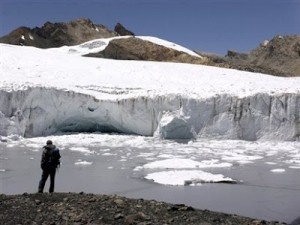 Ice fields in Andean South America are rapidly losing volume and in most cases thinning at even the highest elevations, contributing to sea-level rise at “substantially higher” rates than observed from the 1970s through the 1990s, according to a study published recently. The findings spell trouble for other glaciers worldwide.
Ice fields in Andean South America are rapidly losing volume and in most cases thinning at even the highest elevations, contributing to sea-level rise at “substantially higher” rates than observed from the 1970s through the 1990s, according to a study published recently. The findings spell trouble for other glaciers worldwide.
The rapid melting, based on satellite observations, suggests the ice field’s contribution to global sea-level rise has increased by half since the end of the 20th century, jumping from 0.04 millimeters per year to about .07 mm, and accounting for 2 percent of annual sea-level rise since 1998.
The southern and northern Patagonian ice fields are the largest mass of ice in the southern hemisphere outside of Antarctica. The findings spell trouble for other glaciers worldwide, according to the study’s lead author, Cornell University researcher Michael Willis. Read more





